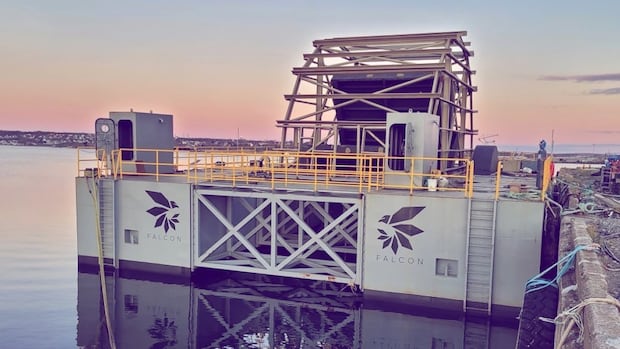‘It is very unfortunate’: Tidal power developer files for bankruptcy

Another tidal energy company that hoped to harness the powerful tides of the Bay of Fundy to generate electricity has come up short.
A spokesperson for the province’s Department of Natural Resources and Renewables confirmed on Wednesday that Occurrent Power, formerly Big Moon Power, has filed for insolvency.
“It is very unfortunate and is a concern for our tidal industry, clean innovation and greening the grid,” Patricia Jreige said in a statement.
Occurrent CEO Jay McKenna and CFO Mike Festa did not respond to messages seeking comment.
After securing a test-site berth at the Fundy Ocean Research Centre for Energy (FORCE) and a lucrative power purchase agreement with Nova Scotia Power, the company appeared poised for success.
Province still holds bond for cleanup
In May, after the restructuring that turned Big Moon into Occurrent, McKenna told CBC News that the company needed to raise more money and he could not say when its floating turbine would be installed to generate power.
The company was facing the added complexity as part of its berth agreement to remove a 1,300-tonne tidal turbine from the ocean floor that was abandoned by a previous company that went bankrupt six years ago. McKenna said in May that Occurrent was “working earnestly to meet the terms of the contract.”
That job will now fall to someone else.
In her statement, Jreige confirmed that the province still has the $4.5-million bond to retrieve the turbine and that officials “will be working on identifying feasible options to retrieve the turbine with those funds.
“The province also holds a separate security for the cleanup of the four temporary gravel pads on submerged Crown lands,” she said.
FORCE executive director Lindsay Bennett said in an email that the company had notified them of the situation shortly after reaching out to the province.
“It’s disappointing to see any company fail in the renewable energy sector; even more so if they exit with unpaid bills. Tidal projects are particularly complex — it’s tough to meet the engineering, financing, and regulatory demands to get a project in the water. Not every company is going to succeed here: the bar is high.”
Last year, a U.K.-based company engaged in a similar endeavour in the Bay of Fundy met a similar fate. Sustainable Marine Energy said its Canadian subsidiary was being placed into bankruptcy, resulting in a loss of at least $30 million.
Fisherman and marine conservationist Darren Porter said he’d been working with Occurrent Power in its various forms for seven years and they were using land he owns in Walton to deploy moorings.
“They were the best to work with of all the companies,” he said in an interview.
Porter said he had high hopes for the project. Unlike some tidal energy companies, he said Big Moon’s device design did not create concerns about fish health and the company did good work on community engagement.
Concerns about device debris
But Porter said things seemed to be less personable after the corporate restructuring last spring.
“It was more distant, less communication.”
Although he’s owed money by the company, Porter said his primary concern is the debris building up on the ocean floor with each failed tidal energy enterprise, which includes the moorings installed for this most recent project.
“They’re a navigational issue and they need to be moved,” he said. “We can’t keep running industry that leaves junk laying around for the people of the Minas Basin to have to deal with.”




